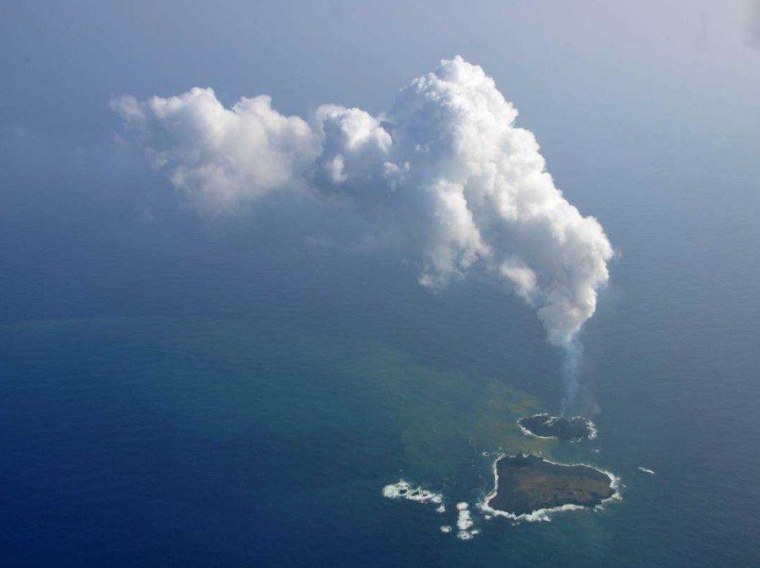Clouds of steam and other volcanic gases mark the birth of Niijima, a new volcanic island off the coast of Japan, in a space snapshot captured by NASA's Earth Observing 1 satellite.
Niijima rose up from the Pacific last month, about 600 miles (1,000 kilometers) south of Tokyo and only 500 meters (yards) from another volcanic island called Nishimo-shima. That island sprouted from the sea in 1973 and 1974. Now Nishino-shima's volcanic arc, part of the Pacific's "Ring of Fire," has given birth to a new stretch of land.
In the Dec. 8 picture from EO-1's Advanced Land Imager, you can see how volcanic activity is stirring up sediment around the edges of the baby island, and how puffs of steam are streaming southward. Aerial photography from the Japan Coast Guard also documents Niijima's growth. This week, the Coast Guard reported that Niijima has grown to 0.08 square kilometers (19.8 acres) in area, which is five times its initial size.
How long will Niijima stick around? "As the volcanic eruption is still continuing, we don't know the fate of the island," the Japan Meteorological Agency's Tomoyuki Kano told AFP. "But it won't disappear in days or weeks, and will probably last for several years ... unless a huge volcanic eruption happens and blows it apart."
That assessment is in contrast with the outlook for Zalzala Koh, the soft "mud island" that rose up off the coast of Pakistan near Gwadar in the wake of a deadly earthquake on Sept. 24. Zalzala Koh is gradually sinking back into the Arabian Sea and probably won't last another year.
The satellite image of Niijima is part of the Cosmic Log Space Advent Calendar, which highlights daily views of Earth from space from Dec. 1 to 25. For more Advent calendar goodies, check out The Atlantic's Hubble Advent Calendar, Zooniverse's Advent calendar and the Galileo's Pendulum Science Advent Calendar.

Previously on the Space Advent Calendar:
- Day 18: Red and green lights glow in space
- Day 17: A child's face, visible from space
- Day 16: Where the Middle East's snow shows
- Day 15: Snaky Colorado river tricks the eye
- Day 14: A space farewell to Nelson Mandela
- Day 13: Happy St. Lucy's Day from space
- Day 12: Island of Love needs healing
- Day 11: A fractal puzzle, seen from space
- Day 10: London and Paris light the night
- Day 9: 'Starry Night' at sea
- Day 8: Mount Etna makes its mark
- Day 7: Staring down into Mount Vesuvius
- Day 6: Grand Canyon, seen and unseen
- Day 5: NASA salutes Nelson Mandela
- Day 4: Twin volcanoes act up in the Pacific
- Day 3: Syria's medieval marvel marred
- Day 2: Where the rain in Spain goes
- Day 1: Farewell, Earth ... Hello, Mars!
Alan Boyle is NBCNews.com's science editor. Connect with the Cosmic Log community by "liking" the NBC News Science Facebook page, following @b0yle on Twitter and adding the Cosmic Log page to your Google+ presence. You can also check out "The Case for Pluto," my book about the controversial dwarf planet and the search for new worlds.
